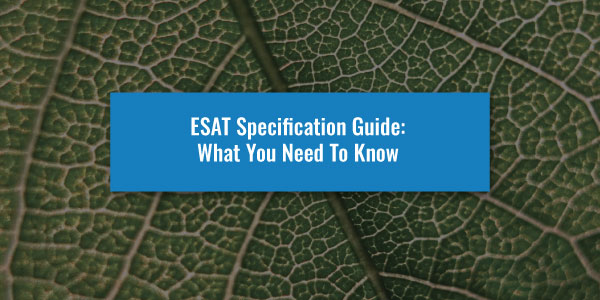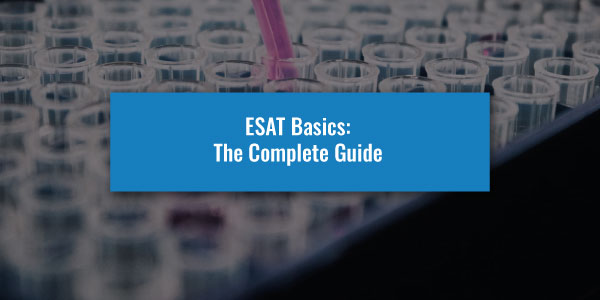The NSAA is being replaced by the ESAT exam. You can read more about the new exam here. NSAA past papers will still be useful when preparing for the ESAT.
When applying to Cambridge to study Natural Science, the NSAA is an important step of the application process.
As you might expect, the NSAA is not like any other test you have ever sat and in line with this, so is how it is scored.
Which is why we have put together this guide going over everything you need to know about the scoring and results of the NSAA.
What makes the NSAA scoring so different?
Throughout your schooling so far, the exams you have sat have most likely been scored as a percentage with the aim of getting as close to 100% as you can.
The scoring of the NSAA does not follow this method, and this guide will help you decipher how this works and how to interpret your results.
Searching for NSAA support to boost your score?
The NSAA is a vital component of your Natural Science and Veterinary Science application so scoring highly can mean the difference between an offer or rejection.
Discover our NSAA Programme by clicking the button below to enrol and triple your chances of success.
When do you get your NSAA results?
Firstly, you will likely be wondering when do you actually get your results.
Students who sit the NSAA on the 19th October 2023 you will be issued with a PDF Statement of Results on the 29th November 2023.
You will not need to do anything as your results will be passed directly to the Cambridge college that you have applied to.
How is the NSAA Scored?
The NSAA is split into two sections, with 60 raw marks available across them. There is no negative marking in the NSAA.
Your results for each part will be reported separately.
However, your NSAA result is presented as a score ranging between 1.0 and 9.0 – with typical candidates scoring around 4.0.
Approximately 10% of applicants will achieve scores higher than 7.0. Low scores are capped at 1.0.
To get the reported score, though, the marks need to be converted from their raw marks.
NSAA Score Conversion
The conversion is adjusted each year in line with the results that candidates achieve.
However, by looking at the conversions from 2021 (taken by those applying for 2022 entry), we can see how this has been applied.
| S1 Maths Raw | S1 Maths Reported | S1 Physics Raw | S1 Physics Reported | S1 Chemistry Raw | S1 Chemistry Reported | S1 Biology Raw | S1 Biology Reported |
|---|---|---|---|---|---|---|---|
| 0 | 1 | 0 | 1 | 0 | 1 | 0 | 1 |
| 1 | 1 | 1 | 1 | 1 | 1 | 1 | 1 |
| 2 | 1 | 2 | 1 | 2 | 1 | 2 | 1 |
| 3 | 1 | 3 | 1 | 3 | 1 | 3 | 1 |
| 4 | 1 | 4 | 1 | 4 | 1 | 4 | 1 |
| 5 | 1.6 | 5 | 1.5 | 5 | 1 | 5 | 1 |
| 6 | 2.2 | 6 | 2.2 | 6 | 1 | 6 | 1.5 |
| 7 | 2.6 | 7 | 2.8 | 7 | 1 | 7 | 2 |
| 8 | 3.1 | 8 | 3.4 | 8 | 1.6 | 8 | 2.6 |
| 9 | 3.6 | 9 | 4 | 9 | 2.1 | 9 | 3.1 |
| 10 | 4 | 10 | 4.6 | 10 | 2.6 | 10 | 3.6 |
| 11 | 4.4 | 11 | 5.1 | 11 | 3.2 | 11 | 4.1 |
| 12 | 4.9 | 12 | 5.7 | 12 | 3.7 | 12 | 4.6 |
| 13 | 5.4 | 13 | 6.3 | 13 | 4.3 | 13 | 5.1 |
| 14 | 5.9 | 14 | 6.9 | 14 | 4.8 | 14 | 5.6 |
| 15 | 6.4 | 15 | 7.6 | 15 | 5.5 | 15 | 6.2 |
| 16 | 7 | 16 | 8.3 | 16 | 6.2 | 16 | 6.9 |
| 17 | 7.7 | 17 | 9 | 17 | 7 | 17 | 7.7 |
| 18 | 8.6 | 18 | 9 | 18 | 8.1 | 18 | 8.8 |
| 19 | 9 | 19 | 9 | 19 | 9 | 19 | 9 |
| 20 | 9 | 20 | 9 | 20 | 9 | 20 | 9 |
| S2 Physics Raw | S2 Physics Reported | S2 Chemistry Raw | S2 Chemistry Reported | S2 Biology Raw | S2 Biology Reported |
|---|---|---|---|---|---|
| 0 | 1 | 0 | 1 | 0 | 1 |
| 1 | 1 | 1 | 1 | 1 | 1 |
| 2 | 1 | 2 | 1.3 | 2 | 1 |
| 3 | 1 | 3 | 2.3 | 3 | 1.3 |
| 4 | 1 | 4 | 3 | 4 | 2.1 |
| 5 | 1.6 | 5 | 3.6 | 5 | 2.7 |
| 6 | 2.1 | 6 | 4.2 | 6 | 3.3 |
| 7 | 2.6 | 7 | 4.7 | 7 | 3.8 |
| 8 | 3.1 | 8 | 5.1 | 8 | 4.2 |
| 9 | 3.6 | 9 | 5.6 | 9 | 4.7 |
| 10 | 4 | 10 | 6 | 10 | 5.1 |
| 11 | 4.4 | 11 | 6.5 | 11 | 5.6 |
| 12 | 4.9 | 12 | 6.9 | 12 | 6 |
| 13 | 5.3 | 13 | 7.4 | 13 | 6.5 |
| 14 | 5.8 | 14 | 7.8 | 14 | 7 |
| 15 | 6.4 | 15 | 8.4 | 15 | 7.5 |
| 16 | 7 | 16 | 9 | 16 | 8.2 |
| 17 | 7.7 | 17 | 9 | 17 | 8.9 |
| 18 | 8.6 | 18 | 9 | 18 | 9 |
| 19 | 9 | 19 | 9 | 19 | 9 |
| 20 | 9 | 20 | 9 | 20 | 9 |
What Can we learn from past NSAA Scores?
Unfortunately, Cambridge Assessment Admissions Testing (CAAT) does not provide data beyond the previous year’s results, so we only have 2021’s data to go off of.
But we can still look at the results to give you an idea of how the previous cohort performed.
What is important to consider when looking at the score distributions is that only Section 1 Mathematics is compulsory, and therefore the only section taken by all applicants.
Subsequently, there is no consistency between the distribution of the other parts as there will not be an even split between who opts to take them.
The distribution of scores (seen below) is used to clearly show candidates just how similarly matched applicants are. It also serves as a good reminder that only the most exceptional applicants will achieve a 7.0+.
With this in mind, we can take a look at the 2021 NSAA results.
NSAA Section 1 2021 Results
Below you can see the score distributions for Section 1 Mathematics, Physics, Chemistry and Biology. As you will be able to see between 4.0 and 5.0 is where the median point of the results tends to sit.
A particularly interesting point is the Chemistry scores, where over 20% of candidates scored just a 1.0. Though as already mentioned, this has likely been skewed due to fewer people opting to take these questions.
On the other end of the scale, just over 8% of candidates achieved a 9.0 in the Physics section – scoring well above the expected average. Although, roughly the same amount of candidates achieved a 1.0.
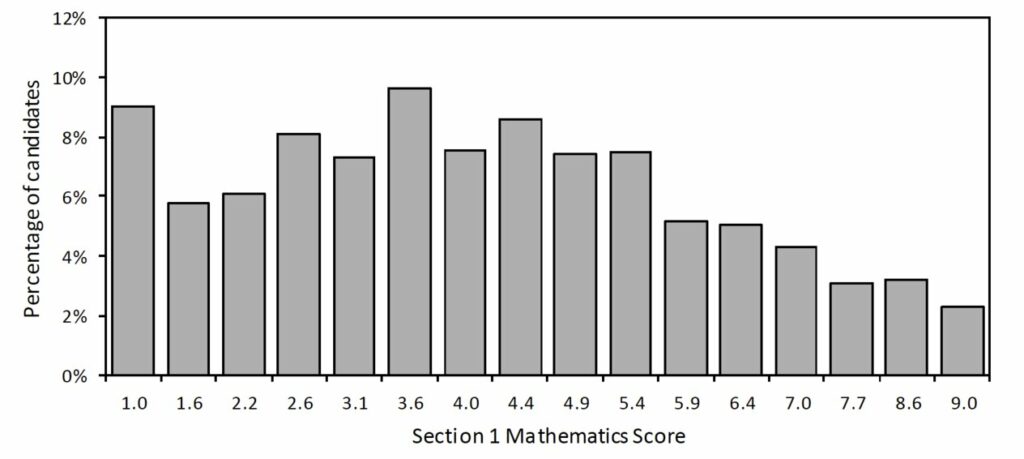
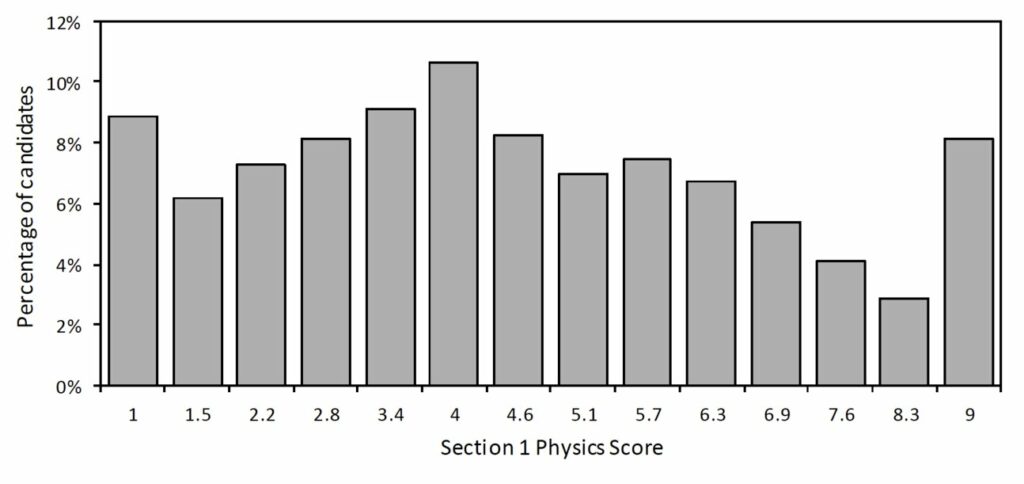
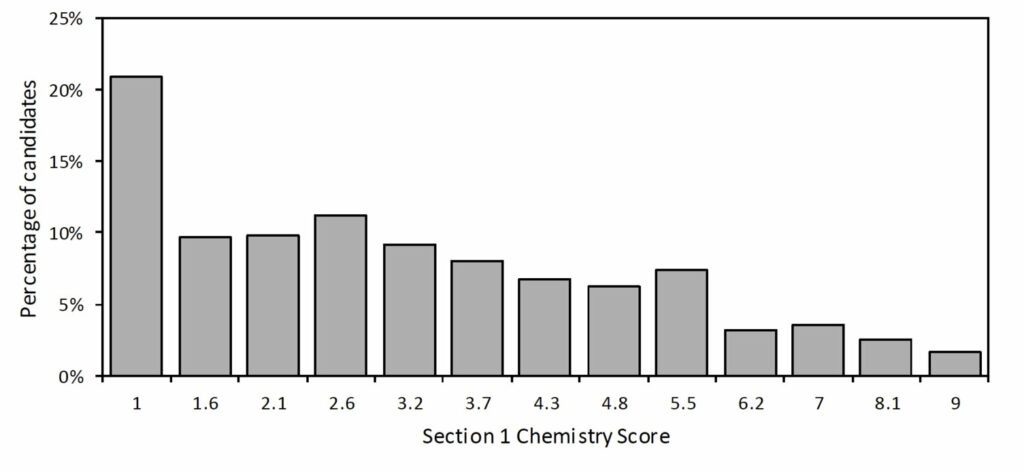
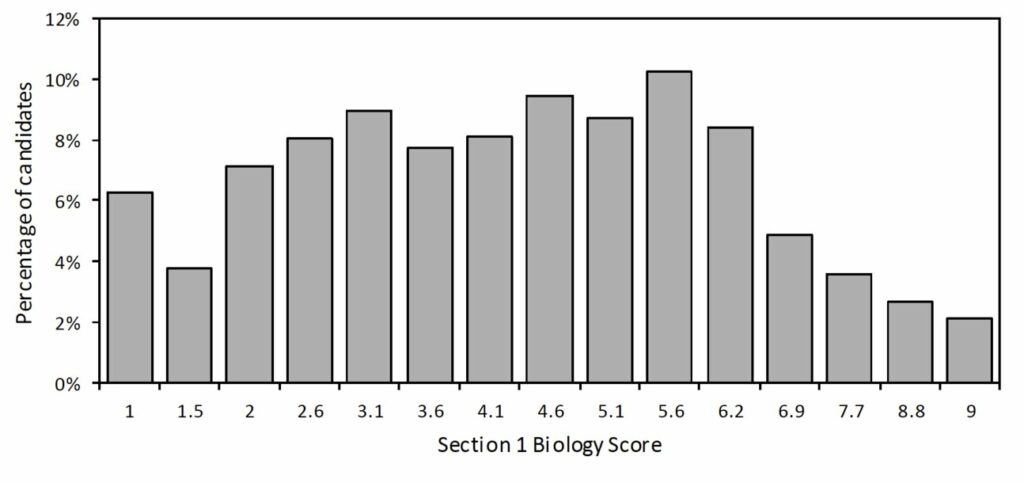
NSAA Section 2 2021 Results
Below is the score distributions for Section 2 Physics, Chemistry and Biology. There is no compulsory section, so candidates answer questions from just one of them.
As we can see, an overwhelming amount of applicants achieved a 1.0 in the Physics section. As already mentioned, this has potentially been skewed by the number of people attempting these questions.
For Chemistry, we can see that the peak of the results was 3.6 – just below the typical score of 4.0.
Biology has a relatively even distribution, with the median sitting between 4.7 and 5.1 – slightly above average.
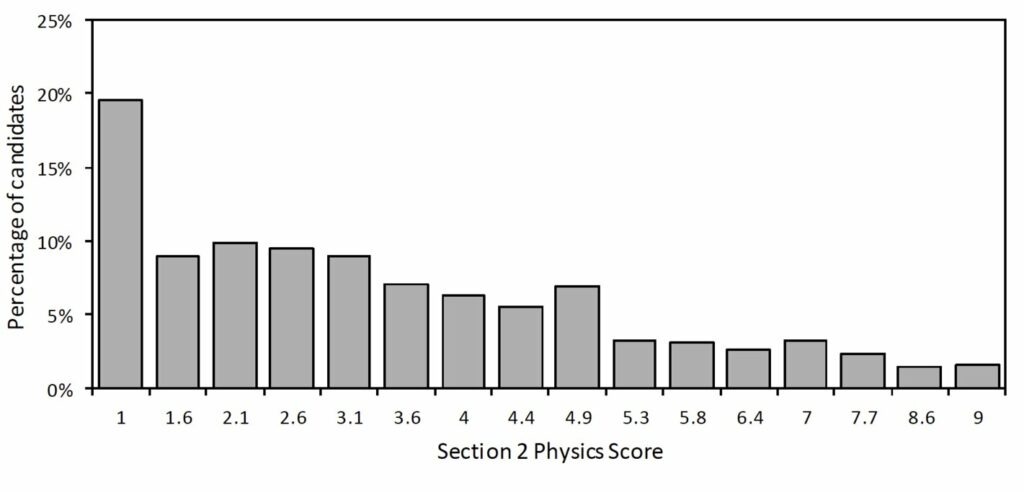
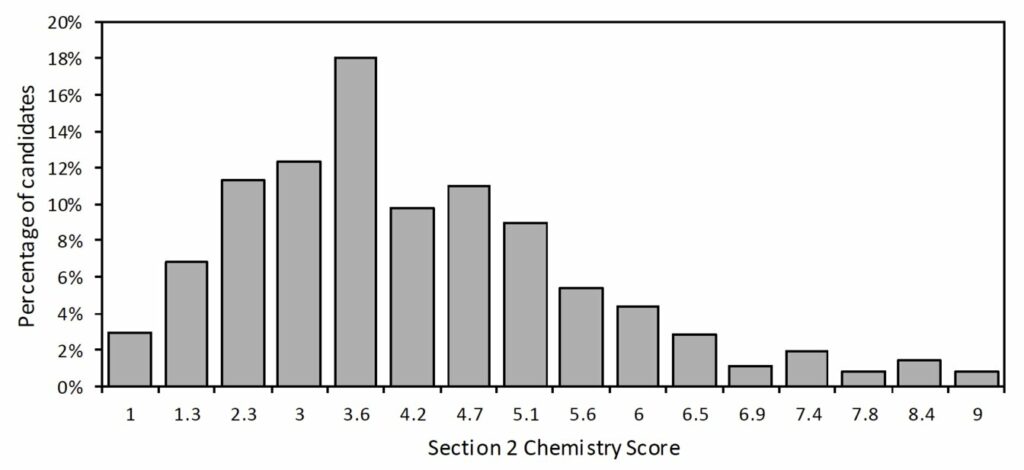
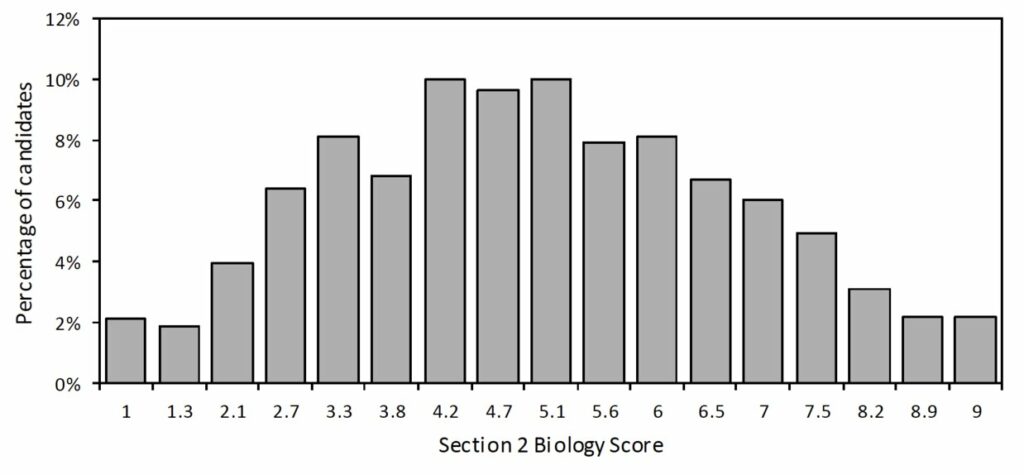
what are good, average, and low NSAA scores?
The distribution tables above provide an idea of what scores candidates have achieved, with a brief explanation of the tables themselves. But what actually is a good, average, or low score?
Based on what we have seen for the previous year’s results and the information provided by CAAT, we can see a pattern in regard to the scores. These can be categorised as follows:
What is a Good NSAA Score?
It is generally agreed that anything from 7.0 and above is considered a good NSAA score. Only the most exceptional applicant will achieve this. As you can see in the distribution charts above, around this mark is where there is a drop-off in the results. By achieving a 7.0 or higher, you will be placing yourself in a very competitive position with your Cambridge Natural Science application. Do remember that the NSAA is just one component of the application, so make sure your overall application is as strong as possible.
What is an Average NSAA Score?
For the average NSAA score, you would be looking at anything between 4.0 and 7.0.; the vast majority of applicants will find themselves in this category. Falling into this range means that your NSAA score is not likely to make you stand out against candidates with similar credentials. However, what it will do – especially if you are towards the higher end of the scale – is allow you to pass any thresholds in place, such as getting an Interview offer.
What is a Low NSAA Score?
Anything below a 4.0, therefore, is considered a low NSAA score. Do not feel disheartened by getting this score, as it is not a failure. The issue you are now faced with is ensuring that the rest of your application is as strong as possible. Cambridge considers applications holistically, so by having strong A-Level and GCSE results and Personal Statement, you may still receive an Interview offer.
Conclusion
Hopefully, from the above, you have a better understanding of how the scoring and results of the NSAA works.
What is key to remember is that the conversion table and the distribution of results are not set in stone and will fluctuate each year due to the perceived difficulty of the Admissions Test.
You do not need to achieve a perfect score in the NSAA to do well in it, which is one of the factors which makes it so different to any other exam you would have sat previously.
Whatever your NSAA score may be, remember that it is only a fraction of what makes up your Cambridge application. With a strong Personal Statement and exam results, even the lowest NSAA scores will not hold back your application.
Maximise your NSAA score through effective NSAA preparation.
The NSAA is a vital component of your Natural Science and Veterinary Science application so scoring highly can mean the difference between an offer or rejection. At UniAdmissions, we are experts at boosting your NSAA score and maximising your chances of gaining a place.
Find out more about our NSAA Tuition Programme by clicking the button below.




